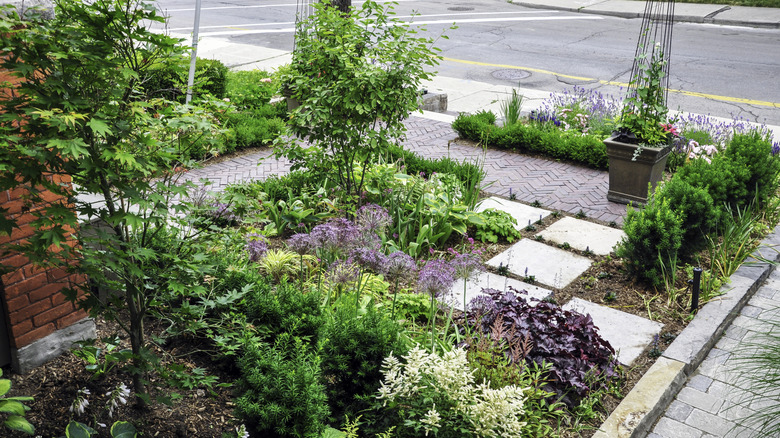The Retro Trend That's Making A Comeback Ditches Grass For Veggie Gardens
There are a lot of trends in landscaping these days: the decades-old keyhole garden trend is making a comeback, homeowners are swapping out backyard lawns for food forests, and the exotic garden trend of planting carnivorous cultivars is gaining traction. But one trend that has a habit of repeating itself quite frequently is the "avant gardening" trend of the 1990s. A throwback to the Victory gardens of the 1940s, it involves getting rid of high-maintenance, unnatural lawns and replacing them with an edible landscape.
With the cost of groceries through the roof, and the occasional threat of supply chain disruptions, more than ever, people are looking to supplement their groceries and become more self-reliant. And what better way to do that than by turning your front yard into a food-producing powerhouse? This trend isn't just for saving money; it's also more sustainable, useful, and beautiful. This practice is not only functional, but it can create amazing curb appeal as well. Modern versions of this trend utilize raised beds, water features, native plants, and creative designs. Whether you're driven by food security concerns or just don't want to spend all your spare time behind a lawn mower, this is one garden trend worth digging into.
How to transform your lawn into an edible landscape
Ready to trade your grass for groceries? Starting your own edible landscape doesn't have to be overwhelming. It's always a good idea to start small — even one garden bed can make a difference. You could also add a couple of fruit trees along the edge of your lawn for a mix of privacy and produce. First, choose the area you want to plant, use a weed eater to cut the grass as close to the soil as possible, and then cover the ground with cardboard (brown, no-ink is best) or newspaper. Now that your ground is ready, either place raised beds or ground beds in your chosen area. Choose a mix of beautiful and edible plants like lettuce, kale, rainbow chard, strawberries, and a variety of herbs. Want more color? Add some edible flowers, like nasturtiums, or some pollinator-friendly cultivars to help your garden grow well.
Use mulch to retain moisture and reduce weeds; opt for drip-irrigation or soaker hoses to water the plants efficiently. Group plants with similar light and watering needs to help cut back on maintenance. If you have an HOA, check the rules — many communities are becoming more open to edible landscaping, especially when they are maintained and look nice, but there could be restrictions. This retro garden trend is a smart way to reclaim your yard's purpose. You'll cut down on grocery costs, reduce your environmental impact, and maybe even inspire your neighbors to do the same.
